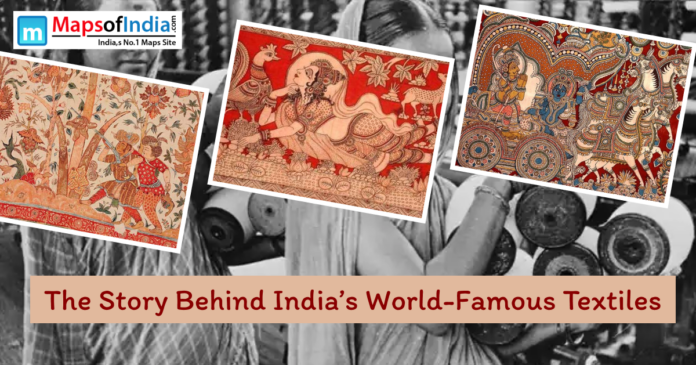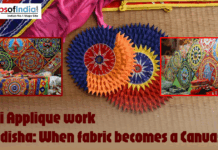India’s textile history is tightly held together by the strong blend of history, cultural values and artistry. All the way back to ancient days and on through fashion today, Indian textiles have amazed the world with their complex designs, vibrant colors and unmatched craftsmanship. This blog follows the story of India’s textiles, uncovering their past, how they have grown and why people all over the world are still drawn to them.
Ancient Origins: Weaving Through Time
Approximately 2500 BCE, the Indus Valley Civilization gave birth to Indian textiles. Findings such as spindle whorls and dyed cotton show that people in this early culture could spin and weave. The oldest remaining cotton threads from India go back to about 4000 BCE and dyeing of fabrics in the region appears in records from 2500 BCE.
Because textiles mattered so much in India, the ancient Greeks and Babylonians called the country ‘India’ as a synonym for ‘cotton’. Through this grouping, we see the great influence Indian textiles had in early global and cultural trade.
Regional Diversity: A Kaleidoscope of Traditions
Because India is home to so many diverse cultural groups, there are several regional variations in the techniques used to create textiles and their designs:
- Gujarat: Gujarat has long been a major player in the textile industry and is famous for its vibrant Bandhani and intricate Patola weaves.
- Andhra Pradesh: The state is renowned for its Pochampalli ikat and Telia Rumal textiles which include geometric shapes and bright colors.
- West Bengal: The fine Jamdani muslin is made by weaving floral and geometric patterns into cotton thread.
- Tamil Nadu: The silk sarees produced in Tamil Nadu’s Kanchipuram are renowned for displaying multiple rich colors, along with gold-threaded borders.
- Kashmir: There, Pashmina shawls are made from the superfine wool of Himalayan goats and are considered a luxury.
Every region’s textiles display its unique culture, beliefs and nature which together create the incredible diversity in Indian textile art.
Global Influence: Threads Across Continents
For many years, Indian textiles have been prized around the world. During the medieval period, people in Europe, the Middle East and Southeast Asia wanted Indian cotton and silk fabrics. In the 16th century, the fashion for chintz spread, which was a brightly colored Indian cotton fabric. Europe’s elite were drawn to chintz because of its detailed flower patterns, as introduced by traders from the Netherlands and Portugal in the 17th century.
The fame of Indian textiles was so great that France and England put a temporary ban on them in the late 17th to 18th centuries to help their industries survive. While there were these restrictions, people still wanted Indian fabrics, which played a role in forming international fashion and textile practices.
Colonial Impact: A Fabric of Resistance
The British conquest of India greatly influenced India’s textile sector. By choosing to import British textiles, Britain led to India’s vulnerable handloom sector shrinking. At the same time, textiles came to stand for resistance as India fought for independence.
In promoting khadi, Mahatma Gandhi chose a form of hand-spun and handwoven cloth that also had strong political meaning. Gandhi pushed people to use khadi to help rural villages recover and make themselves less dependent on the British economy. Right now, khadi represents India’s heritage and tough spirit.
Modern Revival: Tradition Meets Innovation
Lately, people around the world and in India have shown greater interest in traditional Indian textiles. Traditional handicraft methods are combined with current designs by producers to please present-day buyers.
Tigra Tigra uses traditional Indian textiles and African beadwork in its current clothing styles. Taking advantage of partnerships with women’s cooperatives in Ahmedabad, India, AIANDIS employs various traditional techniques such as mashroo weaving, aari and kutch hand-embroidery and leheriya tie-dyeing.
Likewise, ITOH and 11.11 combine classic khadi with new patterns to make attractive clothes for a worldwide market. Because of its history in India’s craft scene, khadi highlights slow-paced production and attention to where and how things are made.
Economic Significance: Weaving Prosperity
India’s textile industry still provides jobs to more than 35 million people, making it the second biggest source of jobs in the country. About 4% of global textile and apparel trade comes from the Indian textile industry which is one of the biggest in the world.
India grows the highest amount of both cotton and jute and it comes second for producing silk. Experts expect textile exports to rise to $45 billion by 2025, with 2020 seeing $38 billion in textile exports.
Sustainable Practices: A Green Thread
Because more people around the world are aware of environmental concerns, the Indian textile sector is using sustainable techniques. Eco-friendly fashion takes advantage of methods that use natural colors and are woven by hand which reduces the amount of carbon released. A number of actions have been taken to encourage growing organic cotton and using green production methods.
The nation’s textiles and fashion industry expects to see major development and grow its value from $150 billion to $350 billion by 2030. Even so, development should meet tough worldwide and local goals for sustainability. Factories are encouraged to set up rooftop solar power and biomass boilers using natural waste, hoping to cut their greenhouse gas emissions.
Conclusion: A Legacy Woven in Time
Indian textiles tell the story of a civilization over the course of its development. Even as it expanded from the old ways to today’s ateliers, Indian textiles never stopped being durable, inventive and glorious. As more people choose sustainable and culturally important goods, India’s textile industry continues to highlight the lasting importance of handcrafts and culture.




